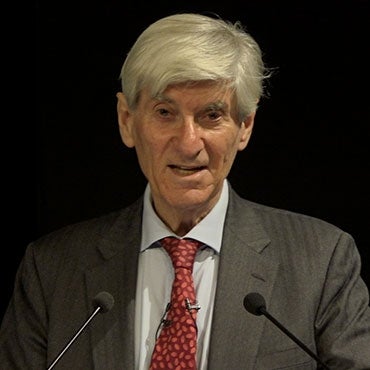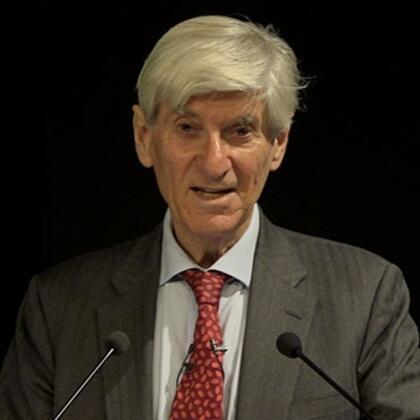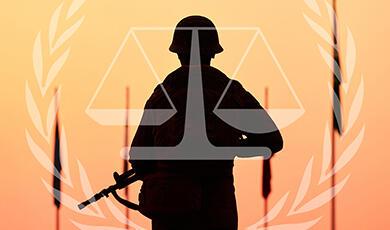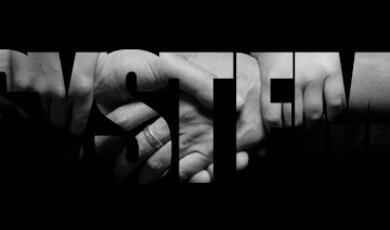The General Election and the Constitution
Share
- Details
- Text
- Audio
- Downloads
- Extra Reading
Download Text
The General Election and the Constitution
Professor Vernon Bogdanor
I am sure everyone was interested in the General Election results. I am not going to talk about which party one might have voted for, but some of the general features of the results that stand out.
I think that everyone noticed that the Labour Party was returned to office with a fairly large working majority of 66 – pretty comfortable for a five year Parliament – but on only just 35.2% of the vote, and that meant that nearly 65% voted for other parties – that’s nearly two-thirds of those who voted. So the Government was supported by just over a third of the voters and rejected by nearly two-thirds of the voters. This does cast light on something often said about British government, that we get strong government in this country, but is it a strong government if nearly two-thirds of those who vote don’t want it?
That percentage of the vote was lower than that secured by any government with a secure majority in Britain in the 20 th Century. The next lowest was 38%, which was gained by the Conservatives in 1922, a long time ago. The 35% figure, interestingly enough, was a lower percentage of the vote than Labour gained at many elections which it lost in the years after the War. For example, it lost the elections of 1951, 1955, 1959, 1970 and 1979, and in each of those elections, it gained more than 35% of the vote. Let me mention in particular the General Election of 1979, after the Winter of Discontent, which I certainly remember and perhaps some of you do too, when it was said how unpopular the Callaghan government was, but it gained more than 35% of the vote that Tony Blair has gained this year.
Furthermore, another feature of the election that many people noticed was that the turnout was very low. It wasn’t quite as low as last time, when it was 58% of the vote, that was the lowest we’ve had since universal male suffrage in 1918, but it was the second lowest, at 61.3%, that is just over three-fifths of the eligible electorate voted. The 58% last time includes some very interesting figures because, contrary to what is sometimes thought, the older you are, the more likely you are to vote, even if you may find it difficult to get to the polls. Amongst young people of 18 to 24, just 39% voted last time, that’s two-fifths, and amongst young woman between 18 and 24, the so-called high-heeled vote, only 33% voted, that is, one in three young women voted. The magazine Cosmopolitan, which does not always concern itself with political issues, which I confess is not my staple reading, rang me up before the General Election to ask what I thought could be done about this. I offered a suggestion, which they actually took up. I said they might submit a questionnaire of issues which are of interest to young women to the three party leaders and publish their replies, which they did. Whether it had any effect on the turnout, we shall see, but it’s one of the rare occasions when Cosmopolitan published an article on politics.
If you take the turnout at the last Election, it’s about 61.3%, just over three-fifths – and this despite the fact there were a number of important issues people were excited about, Iraq and so on, and postal voting was introduced, to encourage voting – despite that, if you take account of that, of the total electorate, not just those who voted but the total electorate, just 21.6% voted Labour; just about over a fifth of those qualified to vote voted Labour. Or you can put the point another way: there are 44 million electors in Britain today, and of those 9.6 million voted for the Government, which is a fairly small percentage of the total electorate.
So I think you would agree that what we have is not government by the majority party, but government by the strongest minority party, and that a fairly small minority party of 35%. The last time any government party achieved 50% was in 1935, though in the years immediately after the War, governments tended to get near that, when there were only two parties. The Liberal Party was very small. For example, in 1951, it gained just 2.5% of the vote, though the government then got about 49% and people didn’t mind about that much. But no government has achieved 50% of the vote since 1935, and no government has achieved even 45% of the vote since 1970 – 35 years ago was the last time that a government was elected with the votes of 45% or more.
If you look at the last few elections we’ve had, one thing that’s very noticeable is that we’ve had a number of landslide elections in recent times. By a landslide, I mean a situation when a government is returned with a majority of over 100. Now, as I’m sure you know, Tony Blair was returned with two landslides, in 1997 and 2001, and those with longer memories will remember that Margaret Thatcher had two landslides, in 1983 and 1987. So we’ve had four landslides, but in none of these landslides did the winning party get more than 43% of the vote, that is, just over two-fifths of the vote. So nearly three-fifths of the voters voted against governments which got those landslides.
We tend to think, if we’re interested in history, that the 1980s were the era of Margaret Thatcher, Thatcherism if you like. She won two landslides. In 1983, she got a majority of 144, and in 1987, she got a majority of 102, but each of those landslides was won within 42% of the vote. In other words, at the very heyday of her power, if you like, 58% of those who voted, nearly three-fifths, voted against her.
There are some further points I think worth noting about the recent election. Only about a third of MPs gained over half of the votes in their constituency, about 34%. That’s the lowest figure in our history. Only one-third of MPs actually gained over 50% of the vote in their constituency. So around two-thirds of MPs were opposed by the majority of voters in their constituencies and, interestingly enough, not one MP polled a majority of the electorate in his or her constituency, and only three got over 40% of the electorate in their constituency, one of them being Gerry Adams, the Sinn Fein leader in Northern Ireland.
So our system of government, for better or worse, gives us government by the largest minority party and not the majority. That, you may think, is perhaps more worrying in Britain than it would be in some other democracies because we, unlike most democracies, give a tremendous amount of power to the government of the day. We’ve got an unprotected constitution, which is dominated by the principle of Parliamentary sovereignty, the idea that Parliament can do what it likes, which means, these days, that the government which has a majority in the Commons can do broadly what it likes.
We don’t have the checks on government that many other countries have. For example, we don’t have a constitutional court which can strike down legislation that goes against human rights. We don’t have a federal system, as America does or Australia, where there are limits on the power of the central government. We’ve got a very weak second chamber, weak House of Lords, compared with second chambers in a number of systems of government, like America or Germany. We’ve also got very weak local authorities which can’t really withstand a determined central government. So we do put all our eggs, as it were, in the basket of a strong central government.
That’s a first feature of our democratic system, that in place of majority rule, we have rule by the strongest minority. But there is a second requirement also of democratic government, not just that the majority should rule, but also that all minorities should be significantly represented so that they can put their views forward in Parliament. Let’s look at how our system meets the second requirement.
The point many people make who are interested in electoral systems and the way Britain works is that a third party in the system, the Liberals as used to be, now the Liberal Democrats, are generally under-represented in the House of Commons. Now that under-representation is less than it was because the Liberal Democrats have been very successful at targeting particular seats, but there is still some under-representation. They gained in the last election 22% of the vote, just over a fifth of the vote, but about 10% of the seats, so they got about one-tenth of the seats for a fifth of the vote. You can put it another way, that to elect a Labour MP, it took 27,000 votes roughly; to elect a Liberal Democrat MP, it took 96,000, so you need a lot more votes if you’re a Liberal Democrat to get someone in.
But the Liberal Democrats weren’t the only minority party to be under-represented. The United Kingdom Independence Party, UKIP, which calls for British withdrawal from the European Union, gained over 600,000 votes but no seats at all. So Labour won one seat for every 27,000 votes, the Liberal Democrats got one seat for every 96,000 votes, but UKIP got no seats for 600,000 votes. UKIP was in fact the fourth party in terms of voting strength in the election, after Labour, the Conservatives and the Liberal Democrats. But seven parties winning fewer votes that UKIP won seats – the Scottish Nationalists, for example, Plaid Cymru, Sinn Fein, George Galloway’s Respect Party, they are four of the seven, as well as two Independents, who of course got fewer votes because they stood in specific constituencies. They all won seats, but UKIP did not win a seat on 600,000 votes.
Let’s look a bit more closely at one part of the United Kingdom : Northern Ireland. I think those who followed the election there will remember that one important feature of that result was the success of the Reverend Ian Paisley’s Democratic Unionist Party, the DUP, which won nine of the eighteen seats in Northern Ireland. It won half the seats, and that was primarily at the expense of what’s often called the Official Unionists – I think their actual title is the Ulster Unionist Party, but they’re generally called the Official Unionists to distinguish themselves from the DUP – and that is David Trimble’s party. They won just one seat as compared with Paisley ’s nine seats, and Trimble himself, the leader of the Official or Ulster Unionist Party was defeated in his own constituency. But if you look at the votes cast in Northern Ireland, Ian Paisley’s DUP won 33% of the vote, and the Ulster Unionist Party won 18% of the vote, so just over a 2:1 difference in terms of votes resulted in a 9:1 difference in terms of seats.
Now, what happens in Northern Ireland doesn’t affect the outcome of the government of Westminster, or didn’t on this particular occasion, but it is interesting all the same because I think it could mislead a lot of people as to the state of opinion in Northern Ireland because, after all, Ian Paisley’s party won a half of the seats in Northern Ireland, so it’s easy to think that they must have the support of 50% of the voters in Northern Ireland. Of course they don’t, they have the support of 33%. Similarly, you might think as David Trimble’s party had only one seat out of 18, they’ve got hardly any support, but in fact they’ve got more than that, they’ve got 18% of support.
The factor about UKIP that I mentioned could also mislead people because since they’re not represented in Parliament, you might think that that option, that Britain should leave the European Union, is not supported by anyone in Britain, but of course it is supported by a lot of people in Britain, 600,000 people in fact, but they’re not represented in Parliament. Their voices aren’t heard, but the voices of people who voted for parties which are much smaller, like George Galloway’s Respect Party, for example, or the Scottish Nationalists, or Plaid Cymru, or Sinn Fein, they are heard in Parliament. So there is an important political consequence, that it misleads people as to the state of opinion in the country on various political options – the Ulster Unionists in Northern Ireland, and the UKIP party in Britain as a whole.
These are two features which are perhaps difficult to dispute about our electoral system. The first is that it doesn’t give power to the majority, but to the largest minority, and the second is that it represents various minorities fairly unevenly and not in proportion to their voting strength in the country. The obvious question to ask is why the system works in this way, and I think to that question there are four reasons rather, which I want to give.
The first, and the most obvious, reason is that the boundaries of constituencies are almost always out of date. There’s very broadly a net movement of population in the country from the inner cities out to the suburbs and into the countryside, and that means, again over-simplifying, fairly crudely perhaps, a movement out of safe Labour seats into marginal seats and Conservative seats. So the boundaries have to be reviewed every so often, and I think they’re reviewed every 15 years. The trouble is, by the time the results are published and acted upon, they’re always out of date, and the consequence is that Conservative seats generally have larger electorates than inner city Labour seats. It’s partly for this reason that it took more votes to elect a Conservative MP in the last election than to elect a Labour MP. To elect a Labour MP, as I said a little while ago, it took you 27,000 votes, but to elect a Conservative MP, it took 44,000 votes and, as I said earlier, a Liberal Democrat 96,000 votes, UKIP well over 600,000. So it’s partly for that reason.
But it’s also partly for that reason that if you look just at England and exclude what sometimes people call patronisingly, the Celtic fringe, Scotland, Wales and Northern Ireland, if you just look at England, the Conservatives actually won rather more votes than Labour in England. They got 1.2% of the vote more, but they won 92 fewer seats, which you may think is very anomalous. That’s one reason then, for the boundary reviews, and the fact that boundaries are always out of date. But I think it’s important not to exaggerate that effect on its own, because even if the boundaries have been drawn so as to secure perfect equity, the effect would have been to reduce Labour’s majority from just 66 to 52, in other words, the boundaries, in my estimate, cost the Conservatives 14 seats. But the government with 35% of the vote would still have enjoyed a large majority even if the boundaries had been perfectly accurate.
The second reason why the system works in, if you like, the unusual way that it does is because of a phenomenon which is much pointed out in the press, which is tactical voting. Tactical voting, at the moment, tends to be anti-Conservative voting on the part of Labour and Liberal Democrat supporters. In the past, it was sometimes different because Liberals, in the early 1950s for example, tended to be more anti-Labour, anti-Socialist, than they were anti-Conservative, but today most Liberal voters tend to be anti-Conservative voters, and many Liberals say if my candidate can’t win in a particular constituency, I would like to do all I can to stop the Conservative winning, and so I will vote Labour. Similarly, presumably Labour people in a seat where they can’t win, where it’s a Liberal/Conservative margin, will say well I’m not myself a Liberal, but anything would be better than the Conservatives, so they vote Liberal.
There was a popular singer, Billy Bragg, who tried to make arrangements on this basis, that he got a scheme together whereby voters in different constituencies would agree to swap votes. It worked in this way: that he would find a Labour voter in one constituency in a Liberal/Conservative marginal, and pair that voter off with a Liberal voter in a constituency which was a Labour/Conservative marginal, and he’s say if I can persuade the Liberal to vote Labour, can I persuade the Labour person to vote Liberal? So it’s a swap, it’s like the pairing arrangement in Parliament in some ways.
Obviously, in that situation, you’d expect that it would take more votes to elect a Conservative than to elect a Labour MP because the Labour vote would be better distributed and they’d get a lot of Liberal votes in seats where the Liberal couldn’t win. That happened a great deal in 1997 and 2001. It did happen to some extent this year, but not as much, and that was probably because of the Iraq War, that there was less basis for agreement, because after all, Labour supported the war, and the Liberal Democrats were the only party which opposed the war, so a number of Liberal Democrats who might otherwise have said we’ll vote Labour, might have said I can’t vote for a party which supported the Iraq War, so we’ll vote Liberal even though we know the Liberals have no chance of winning. There was an effect of tactical voting, but I think probably not as great as before, but nevertheless, it was there.
The third reason, which one can do nothing about, is that turnout was simply higher in Conservative seats than it was in Labour seats, and that would mean it would take more votes to elect a Conservative simply because more people are voting.
But it’s the fourth reason which I think is the crucial one for the way the electoral system works, and that is, that the seats a party receives depend not only upon the number of votes it wins, but how those votes are distributed geographically.
Let’s take one example. Let’s two different parties, which each of them gained 30% of the vote, call them Party A and Party B. Let’s say that Party A gets its 30% of the vote in every constituency. It’s perfectly conceivable – it becomes second in every constituency with 30% of the vote. But Party B is very popular in some constituencies, where it gets 50% or 60% of the vote, let’s say, but very unpopular in lots of other constituencies, gets about 10% of the vote. Party B could win half of the seats on 30% of the vote. So the total vote could be the same, but the important thing is how that vote is geographically distributed. Other things being equal, a party whose vote is geographically concentrated will get more seats than a party with the same number of votes whose vote is evenly distributed geographically.
In the past, not so much today, the Liberal vote tended to be evenly distributed geographically. A very good illustration of this, in 1983, the Liberal SDP Alliance gained 25% of the vote, a quarter of the vote, but just 23 out of about 650 seats in Parliament. They were second everywhere because their vote was quite evenly distributed. They’d have done much better if instead of getting 25% of the vote in every constituency, they’d have got 5% of the vote in half the seats and 50% of the vote, or 40% of the vote, or 45% of the vote in the other half. They would then have won a lot of seats but on the same vote, and so the crucial factor is how those votes are distributed. That incidentally is why the Liberal Democrats have decided to target particular constituencies and they’ve done much better on that basis. In the recent election, they got 22% of the vote but they won over 60 seats. They got a smaller vote than in 1983, but they won about three times as many seats because what they’ve done is to target particular seats, and say we’re not going to bother about the country as a whole, we’re just going to bother about these seats we think we can win and try and build our support up in that way, and that obviously is a successful thing to do under our system.
Let me show you how this works, by looking at the seven minor parties. You can see how oddly the system works, because UKIP and the Greens won no seats at all, but the SNP won six, Ian Paisley’s party, the DUP, won nine, Plaid Cymru, the Scottish Nationals, won three, Sinn Fein won five, and the Ulster Unionists won one. I think this is a perfect illustration of my point. Whether you’re UKIP or Green doesn’t depend on where you live, so broadly speaking, it would be roughly even across the country, the percentage of UKIP or Green support. It’s a particular point of view that you either have or you don’t have, and it doesn’t depend on where you live. But obviously, whether you’re Scottish Nationalist or a Paisleyite or Plaid Cymru or Sinn Fein does depend on where you live, and those parties are going to do much better under our particular system.
Interestingly enough, you can see that effect even within some of those parties, because if you compare the SNP and Plaid Cymru, they’re often thought of as similar but they’re not quite, because the SNP is a party of Scottish Nationalism right across Scotland, but Plaid Cymru is really a party of Welsh-speaking Wales, which is North-West Wales, and it’s strength is very concentrated even within Wales, so that for a vote which is rather less than that of SNP, they get a half of the seats, and Plaid Cymru actually benefits more from the system than the Scottish Nationalists because of the peculiarity, if you like, of the Welsh nationalist vote, which is partly a linguistic vote, in the Welsh linguistic heartland of North-West Wales. But I do think this illustrates the point very well that I’ve made about the evenness of support.
Let me follow on that with a related point, that it’s not only third parties and smaller parties that are weakened by the system, but also a second party in areas where it is the second party. To give one example, if you look at the metropolitan areas outside London, the great conurbations, the Conservatives won just five seats out of 124. That doesn’t mean that no one votes Conservative in the conurbations. In fact, the Conservatives got about a quarter of the vote in the conurbations, about 24%, 1.1 million people in the conurbations voted Conservative, but those people aren’t represented because of the system. In other words, the Conservatives are second in almost all the conurbations, so they don’t have representation.
The same is true the other way round with the Labour Party in the rural areas. A lot of people vote Labour, but they tend not to win many seats. That also has important consequences of policy, because many people say the Labour Party is not very sensitive to rural issues, particularly on matters like hunting. People say the Labour Party doesn’t understand the needs of the countryside. I don’t know whether that’s true or not, but if it is true, it may be because Labour doesn’t have many rural seats.
Then some other people say that well the Conservatives are not very sensitive to the problems of the inner cities. They understand perhaps the countryside, but not the inner cities, and again, that’s because perhaps there aren’t many Conservative MPs representing inner city seats. This is going to be very relevant to the future campaign for the Conservative leadership, because, if the important vote is from Conservative MPs, that will skew the vote to rural areas, where the Conservative Party is strong, and the Conservative voice in the inner cities, and in Scotland and in Wales, won’t be heard in that leadership election, although these are just the areas the Conservative Party needs to gain if it’s to get into government. It’s done pretty well in the rural areas. It hasn’t done as well as it should in the conurbations and in Scotland and Wales, so you need to know how are we going to win those seats? The vote is skewed because the MPs there by definition are those in the areas that they’ve done well, in the rural areas, so the Conservative inner city voice and the Conservative Scottish and Welsh voice is not perhaps very well heard.
So the electoral system disadvantages not only third parties and weaker parties, but also second parties in areas where they are weak. The consequence is to make the country look more geographically and socially divided than it probably is. In other words, if you just look at the number of seats, you think Labour has no support in the countryside, and the Conservatives have no support in the inner cities, and so you look and you think rural England is solidly Conservative, or perhaps Liberal Democrat, and urban England is solidly Labour, but that isn’t the case. There are minorities from those parties, but those minorities are not properly represented.
There is a further factor I mentioned earlier, which is electoral turnout. Is the turnout low because of our electoral system? Some people say it is, but I think we should be cautious about this, because there have been very great variations in the level of turnout in the 20 th Century under the same electoral system. Under this very same electoral system, in 1950, 84% voted, and in 1951, 82.5% voted, as compared with 61.3% in the last election. So there was no change in the electoral system, but a great change in turnout.
But you may say, perhaps the electorate are becoming more sophisticated, and asking themselves why should I bother to vote if the result in my constituency is so predictable, because I live in a safe seat? It’s a safe Labour or Conservative seat, and it would return a donkey to the House of Commons if that donkey was called Labour or Conservative. It wouldn’t matter who the candidate was and my vote would have no effect.
If you look at the figures for 2001 and 2005 showing the turnout of seats with the smallest majorities, that is marginal seats, and seats with the largest majorities, that is, safe seats, you can see a significant difference of about 16% or 17% in turnout, so it is possible to argue that an electoral system which made every seat marginal would encourage more people to vote than a system whereby a lot of the seats are safe seats for one party or another.
There’s a further point worth making, that turnout tends to be at its lowest in the very safe Labour constituencies in the inner cities. For example, the lowest turnout in 2001 was in Liverpool Riverside, where just 34% voted. In this election, it was a bit larger, it was 41.5%, but a very low turnout. These constituencies are often in areas of severe social depravation and social exclusion. You may say that people in these areas need to use their votes even more than those living in more affluent constituencies; it’s more important for them to become civically engaged in the system if they’re to improve their circumstances, but these are the very constituencies where people are least likely to vote, very safe Labour inner city seats, dominated by one particular party.
Let me then draw all these threads together. In the last election, the electoral system seems to me not to have given us a government which represents the majority, and not to have ensured that all significant minorities were reasonably fairly represented – not exactly mathematically perhaps, but reasonably fairly. What it did, it gave us a government representing the largest minority, 35%, and it represents some minorities fairly well, but others hardly at all. Minorities voting for parties whose support was concentrated did quite well, but not minorities voting for nationwide parties, such as, to some extent, the Liberal Democrats, but perhaps more seriously, UKIP and the Greens. The electoral system in particular misrepresented the state of opinion in Northern Ireland, making Ian Paisley’s party appear stronger than it was and David Trimble’s party appearing weaker than it was, and that could have political consequences. It also had the effect of under-representing major parties in areas where they were weak, that is the Conservatives in the inner cities and Labour in the rural areas, and this also could have important political consequences. It’s possible that because of the electoral system, the level of turnout was not as high as it might have been.
I think the difficulty with our system, the Achilles’ Heel if you like, is that under it, the number of seats which a party wins doesn’t depend just on the number of votes it gets, but how those votes are geographically structured and distributed, and that a party whose vote is geographically concentrated will win more seats than a party whose vote is geographically evenly spread. So our system makes the number of seats depend not only on the number of votes but also upon the geography of the votes. You may ask, can we do anything about that? Is there a method of taking the geography out of elections? And then the answer someone might give, well what about proportional representation?
And here I say we’ve got to be careful, because proportional representation is not the name of a single electoral system, but of a whole range of electoral systems which are very different in their political consequences and operate very differently. We’ve got a number of these systems already in use in the United Kingdom. Those who voted for the London Authority would have voted by a proportional representation system very like that in use in Germany. Those who voted in the last European elections voted by a very different system of proportional representation called the regional list system of proportional representation, quite different from that used in London. Those from Scotland or Wales, who voted for the devolved bodies there, will also have voted by proportional representation, this time like the London system, the German system of proportional representation. Those who voted in Northern Ireland for the elections to the Assembly there voted by a third different system of proportional representation called the single transferable vote system. That system is used in the Irish Republic, but it’s also used now for all elections in Northern Ireland except Westminster elections. So I’ve already mentioned three different electoral systems of proportional representation. There are many others – I think about 300 were calculated, but you’ll be pleased to hear I’m not going to go into all of those different systems.
Obviously, you will accept that I pointed out the weaknesses of our electoral system but I think you will probably all suspect that no electoral system is perfect and that anyone who said there was should be scrutinised, very carefully. These other systems, though they might correct some of the weaknesses I have mentioned, might also bring out other weaknesses which our system does not have and therefore I have not mentioned, although our system has hidden advantages which I have not brought out, and these systems have hidden weaknesses. The question we need to ask I think is how successful are these alternative electoral systems at taking the geography out of elections, and what weaknesses do these other systems have?
I hope I’ve convinced you that, although our electoral system might have great virtues, it has also got very considerable weaknesses, and these might affect the way our constitution and democracy operate.
© Professor Vernon Bogdanor, 31 May 2005.
This event was on Tue, 31 May 2005
Support Gresham
Gresham College has offered an outstanding education to the public free of charge for over 400 years. Today, Gresham College plays an important role in fostering a love of learning and a greater understanding of ourselves and the world around us. Your donation will help to widen our reach and to broaden our audience, allowing more people to benefit from a high-quality education from some of the brightest minds.


 Login
Login






